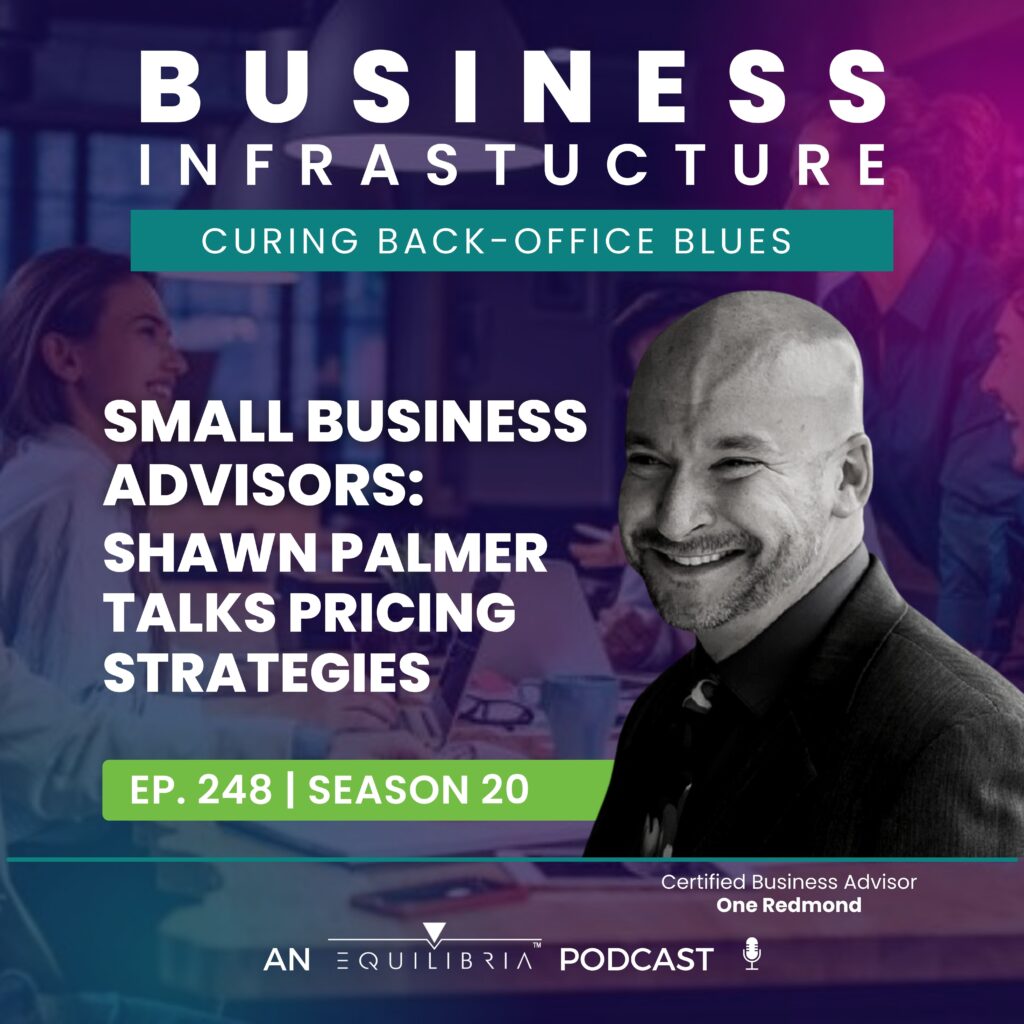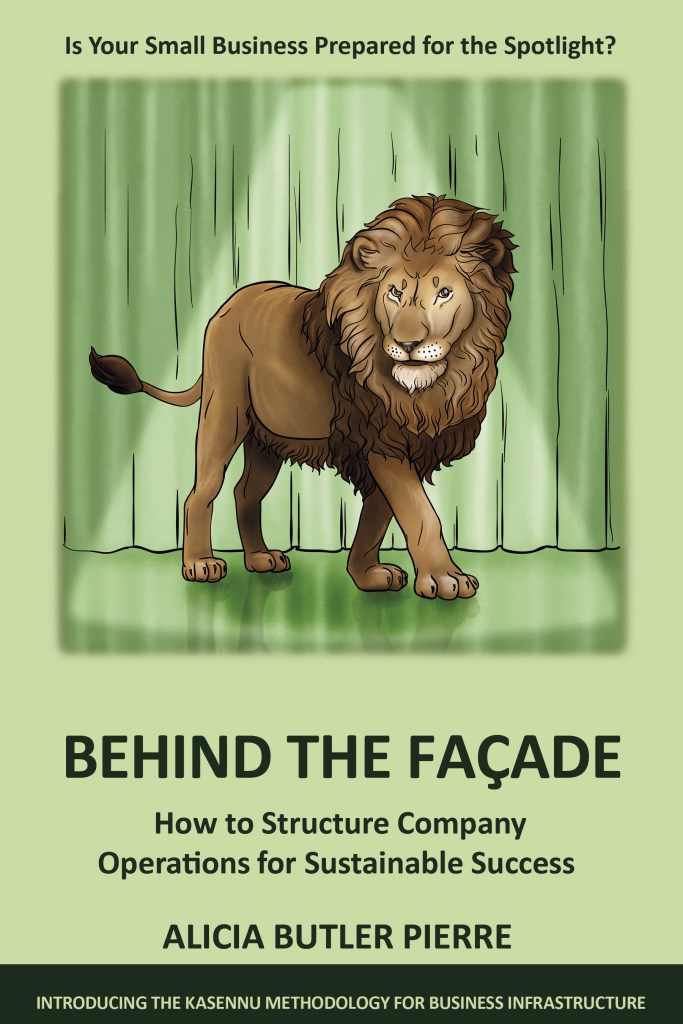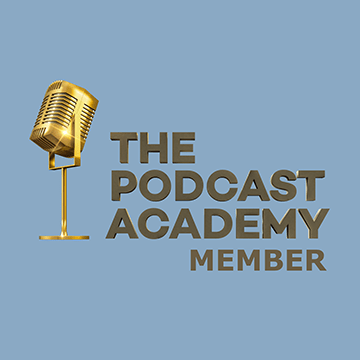Transcript
This episode is underwritten by Equilibria, Inc. the company behind this podcast where we design scale-ready business infrastructure for fast-growing small businesses.

So many entrepreneurs have the mindset of success being, well, we made it another month, just being in business, just surviving and having the doors open. If you’re a small business, first of all, let me congratulate you because you’ve done something that many people dream about, a whole bunch of people talk about, but few people actually do. And let me emphasize the value you have in our national economy, which is predicated on small business, not big. So one, congratulations, and two, you are vitally important. Keep doing what you’re doing. And if you’re on the sidelines thinking you got a great idea, pursue that because you are going to be the next era, the next generation of entrepreneurs that add to our national economy. You are vitally important.
That’s a powerful statement from Shawn Palmer. And he’s right – as an entrepreneur, you are vitally important.
Welcome to Season 20 of the Business Infrastructure podcast. This season we’re featuring small business advisors. Over the next 12 episodes, these advisors will share specific tips, tactics, and strategies to cure any back-office challenges you may be experiencing. As always, these lessons will be presented with a focus on business infrastructure – that is, the people, processes, and tools you need to not just grow your business, but scale it in a repeatable, profitable, and sustainable way.
Speaking of profitability, our first guest is a small business advisor with One Redmond, an organization that sponsors the Washington Small Business Development Center, also known as an SBDC. He specializes in pricing for profitability. Prepare to take notes because he has a lot to share!
This is Episode 248 – Shawn Palmer Talks Pricing Strategies
Shawn, welcome! How are you today?
I’m great, and I’ll tell you what, I’m excited to be kicking off season 20 with you, Alicia.
Thank you for agreeing to do this interview. And for those of you who might be watching or listening to this right now, if you’re not based in the United States, Shawn, could you please first explain what the heck is an SBDC for those who’ve never heard of the SBDC?
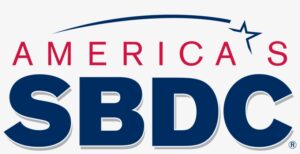
Well, we are the best kept secret in small business. We are a resource partner of the Small Business Administration who in large part funds us to provide confidential one-on-one no cost, small business advising, to help entrepreneurs and established businesses through the fun challenges of startup, growth, resilience, and ultimately transitional.
Each state has one. Some of the larger states like California and Texas will have more than one. And within each SBDC, our satellite offices each staffed with, talented, and, and committed advisors, eager and, and ready to help, small businesses throughout the country.
There’s over 1,000 SBDCs across the U.S. And in case you missed what Shawn said, another best kept secret about them is that their services are free!
The non-financial cost that I share is your commitment. You come ready to give a hundred percent. I will more than happily meet you halfway and give you my best and my a hundred percent as well as will all of the other advisors in our network and throughout the country.
Shawn works with small businesses located in the state of Washington, through an organization called One Redmond. I was curious about what specifically he does as a small business advisor there.
So, the Washington Small Business Development Center actually has a couple of small subcontractor recipients. So here at One Redmond in Redmond, Washington, just, east of Seattle, we are all of the community foundation, the Chamber of Commerce, and the Economic Development Agency for the city where I serve most of East King County.
I do a little bit of everything, but the value of being in a talented network is that everybody’s got their own subject matter expertise. As I like to explain, I’m bilingual. I speak both English and Math. And so a lot of my expertise rests in that, that business math, not accounting that is outside of my lane. But when it comes to cost benefit analysis and especially, like pricing strategies that’s really where, where my expertise lies.
I find that business advisors have very interesting backgrounds – a unique combination of experiences that, many years later, they harness to help others. And Shawn’s no exception.
Well, the way I explain it, my beautiful daughter is a college sophomore, studying to be an elementary school teacher. So I’ve really been dispensing practical advice for 20 years now, professionally, for about four. and not only am am I a veteran, proudly so, but I’m also an entrepreneur myself. And, and so one thing that I feel my clients really value is my pragmatism, my mission focus, my, my logic-based decision making that comes from the military side, but also the adaptability, the creative problem solving, and the relatability that comes from the entrepreneurial side.
His military side…Shawn’s referring to the fact that he is a Navy veteran.

I was enlisted for five years, gave the Navy Reserve 10 more as an officer. If you speak to a veteran, almost every single one will tell you that the greatest part about what we do outside of the actual service to our nation is the people that we’re involved with. And that absolutely stands up with me. I miss every person I’ve ever served with. but this new, fun, exciting challenge of working with entrepreneurs takes me back to my military roots a little bit. And every day is a little bit different. Every entrepreneur, every business has a slightly different issue, a slightly different way of, of tackling things and how they might solve it. So to be able to work with them and have every day be different is one of the great things about doing what I do.
And what Shawn does so well is developing pricing strategies. I discovered this firsthand when I attended a presentation he gave at the America’s SBDC conference in September 2022. He began by talking about the Law of Supply and Demand. My ears instantly perked up. And I started to take copious notes. It’s rare to find small business advisors who talk about pricing from this perspective. So I was wondering if Shawn could attempt to share what a supply and demand curve looks like with you.
Absolutely. to the best of my ability for those of you who are just listening, the supply and demand curve are two intersecting diagonal lines on an X-Y axis.
Where for a given level of demand, to lower the price means you increase the demand. Think of going to your favorite coffee kiosk and how much busier they would be if they drop their price in half a price drop result in a corresponding increase in demand.
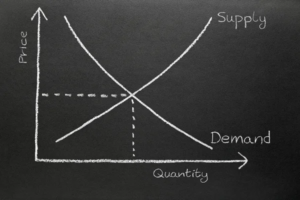
To raise the price would then, of course, lower demand but on the supply curve, the same amount supplied at a given price where it intersects the demand curve is what we call equilibrium. And that’s kind of your revenue box because you’ve got, quantity and price on your x-y a axis. And so multiplying quantity and price gives you your total revenue. What it doesn’t account for is profit, because all we have is how many we’re going to sell out of stated price. What it doesn’t account for is how much it costs the entrepreneur to produce that.
So, you’ve got your revenue box. Now, how to change the size of your revenue box is to sell more. But I share the supply and demand curve to illustrate that we can’t sell 2,000 units of whatever, raise our price, and expect to sell the exact same number of units, whatever it is that we’re doing. If we’re selling coffee or hours of landscaping service, if we raise our price, demand is going to diminish. Now, there’s a way to increase profit, and again, it really helps with the graph and to see it visually. But you can increase profit by raising price, lowering your demand. That is you sell fewer units, but at a higher price and at a lower cost. Therefore, profit increases. Now, the tricky thing about supply and demand curves is, there’s not a, you know, up one down one over one sort of, you know, very equal movement as you move across price and quantity.
Okay, so here’s the gist of what Shawn is saying. Visualize drawing a chart. On the y or vertical axis, you have price. On the x or horizontal axis, you have quantity. Now, imagine a diagonal line starting near the top of the y-axis and going down and across the inside of the chart. That represents the quantity or amount demanded for your product or service. It shows an inverse relationship with quantity. In other words, the higher the price, the lower the quantity demanded.
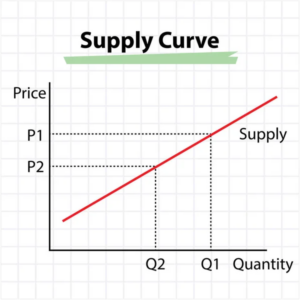
Next, imagine another diagonal line but it goes in the opposite direction where the top of this diagonal line ends in the upper right corner of the chart. Wherever those two diagonal lines intersect is known as “equilibrium” and it lets you know the corresponding price. If you want a higher price, then, as Shawn just described, you move up the demand curve. The key to increasing profitability is to raise your price but keep the supply or the cost of producing your goods or delivering your services, low.
So think of your favorite Italian sports car manufacturer. Very vertical demand curve. That is, they can keep raising their price and demand really doesn’t wane because they are a very luxury good. Now, conversely, think about your favorite big box or discount retailer, and they can lower their price by a little bit in their competitive market. And because they’re working with consumer or staple goods, by lowering the price a little bit and beating their competition, they will actually bring a lot more people over to their supply curve, increasing demand. So they will sell more quantity at a slightly lower price, and they will increase their revenue that way. We’ve seen some of these big discount retailer, these national chains do exactly that. That’s why their prices are as low as they have. It’s, it’s a market-based equilibrium where they are selling as many items as they can, as great a quantity as they can at the lowest price they can to capture the greatest audience and capture the greatest revenue.
Now that we have that baseline for understanding pricing as it relates to supply and demand, I was wondering if Shawn could start sharing more about actual pricing strategies. Using my notes from his presentation at that conference where I first met him, I knew there were five that he usually talks about. The first one is per unit, or a la carte. But what does that mean and how does it work?
So quite literally off the menu, if you want to buy one of something, it’s gonna cost you whatever the price is, X number of dollars and cents. If you buy two, you just multiply that price times two. You’re buying them quantity or at a time, price per quantity. And really a la carte, a lot of businesses think that they’re limited to this pricing strategy. And the example I like to give is, is your favorite family, Mexican restaurant. You go in at dinner and they’ve got 33 dinner entrees. The presentation of the menu is extremely scientific. We see it in menus, we see it in grocery stores. But you look at those 33 entrees, and the restaurant wants you to choose something in the top six of the top eight. The most expensive items are toward the bottom, not because they’re expensive, but because they’re the lowest margin.

The restaurant will sell you the shrimp fajita plate. They would rather sell you the chicken enchilada or the beef tacos. Your eye begins to scan down, you find something, “Oh, I like those!” So there’s a comfort level, there’s a familiarity, and there’s a kind of a middle of the road price point and everything kind of comes together. Yes, I will have #4, guacamole on the side. The restaurant is going to make 80% of their profit for the day, for the week, for the quarter, for a four, six-page menu. They will make 80% of their profit on those six or eight items listed first amongst their entres.
Wow!
And that’s what I guide entrepreneurs to do, is your bread and butter, what you’re best at, what you got into this for should be your highest volume in some of your highest margin efforts. If not, we need to tinker with some things. And that’s where the pricing strategies webinar was first developed.
Don’t go anywhere! Shawn will tell us more about his pricing strategies webinars as well as the other four pricing models after the break.
How do you know if your business is growing faster than you can keep up with? If you have trouble keeping up with things like deliveries and projects. Your customers are angry, team turnover is high, and the complaints are piling up. Where can you go for relief? How can you save your business from the chaos of unmanageable, fast growth?
It might be time to build business infrastructure. Business infrastructure is a system for linking the people, processes, tools, and technologies that act as the heartbeat of your back-office operations. It gives your fast-growing small business a stable foundation to not only continue growing but to scale in a profitable, sustainable, and repeatable way.
That’s why if want a business that can consistently operate without your daily presence, then the Smooth Operator course is for you. It’s an online introductory course on business infrastructure that can provide you with the proven tools, tactics, and techniques to calm the chaos and restore order. Go to SmoothOperator.courses to learn more. That’s SmoothOperator.courses.
We’re back and before the break, pricing expert and small business advisor Shawn Palmer explained the first of five pricing models he’ll cover. The next one is known as the component pricing model. Here’s Shawn…
So most often when you’re at college and it comes time to register for your classes and pay tuition, depending upon if you’re on a a quarter or semester system, the college says, “For this level of tuition, whatever it is, you get 12, 15 up to 18 credits. So long as you come in under this amount, at least be a full-time student and be under this threshold tuition’s the same no matter how you put those components together.
A restaurant example is one of my daughter’s favorites, Panda Express. You don’t really order off a sit down menu at Panda Express. You go to the counter, you decide how many entrees you want, you pick your, your rice or your noodles, and then for one, two, or three entrees, you choose from the dozen. They have an upsell for the steak or the shrimp. But that is a component strategy, one price. And then the purchaser, the customer gets to package that together however they want to.
The next two pricing models are subscription and membership. Shawn likes to combine these whenever he explains them since they are similar in form, but different in practice.
Membership and subscription are sometimes used interchangeably, and they’re very similar, but there’s a distinct difference. Subscription is rooted in periodicity. That is, for a stated price, you get some deliverable once a month, once a week. It might be a magazine that comes in the mail.It might be your landscaper that shows up to mow the lawn. Membership is a stated price for unlimited access. We think we subscribe to cable TV, but that’s a membership because it’s unlimited access. Pay that monthly subscription rate to cable TV or your favorite streaming service. Binge watch one show from start to finish, all 20 seasons of NCIS or go on vacation, never turn the TV on. You get the exact same price, but the value received is different based on how much you decided you wanted to access that. The gym membership works much the same way, whereas in the streaming example, maybe a pay-per-view event, because now we’re adding something off the menu.
So, this combines membership with a la carte. And this is another thing that entrepreneurs don’t always take advantage of, is the opportunity to pair pricing strategies together. First and foremost, as an entrepreneur, as a business owner, we have to provide some value to our customers. If we do, we can almost charge whatever we want because they see value in it. If we fail to do that our pricing strategy won’t matter because our customers won’t see value in it and they will go to a competitor. So, subscription rooted in periodicity, membership rooted in unfettered access.
Does that make sense? If not, then consider this example. The Harvard Business Review offers a monthly subscription for their physical magazine. This is a subscription pricing model since you only receive one magazine per month for a year. On the other hand, Netflix offers a membership pricing model. When you pay a monthly fee for their streaming service, you can watch as many movies as you want. The fifth pricing strategy is block pricing.

So, a block pricing model incorporates a little bit of, of bidding. So perhaps a caterer will do this. As a public speaker, this is the pricing model that I employ. If someone wants me to come and give their morning keynote at their conference or their luncheon, somewhere here in western Washington with our geography and our traffic, I’ll bet you anything that once I deliver that, I can’t get anywhere else where I happen to get something scheduled for the afternoon on the same day. So rather than charge just for the time that I’m there, I charge for the entire day. Now, let’s harken back to what I said about how entrepreneurs have to deliver value. This is not me overcharging or making sure I get mine. This is putting myself on the same side of the table as who’s hiring me so I can deliver maximum value.
So if I say I’m gonna charge you for the entire day, even though I’m only there for an hour and 15 minutes. They are now motivated to be like, well, shoot, as long as you’re gonna be here for the day, will you also moderate our lunchtime round table and would you lead two afternoon workshops if it’s gonna be the same price? To which I say, “Absolutely!” Because now my benefit is as a public speaker, everything I do, I’m auditioning for the next 12 things, the next speaking engagement, the next event or organizer who might wanna hire me. So the more I can do in a single day, this benefits me. I’ve also provided more value to the customer.
I have a confession to make. Pricing is not one of my strengths. So that’s why I asked Shawn to discuss, from a business infrastructure perspective, who he recommends entrepreneurs like me (and maybe even you) add to our teams to help develop, monitor, and adjust pricing. Would it be someone like a fractional Chief Financial Officer?
One of my most two popular answers is, it depends. And here’s what it might depend on. I I think it might depend on the type of business, I think it might depend on the entrepreneur’s familiarity with their own finances. I think it might depend on, on the skillset and the knowledge base that’s already there.
Fractional roles or fractional titles can be extremely advantageous when you are trying to scale. We don’t scale in in little increments. We don’t knock down a wall of our warehouse to add 10 more feet. We get into another lease, or we rebuild something, and now we’ve got twice the capacity that we now have to grow into. You hire a CFO, you hire an HR specialist, they’re gonna be bored for a little bit. You have to let them grow into that capacity. So I think a fractional role for a lot of businesses can be wholly advantageous to get that level of expertise without having to buy the entire thing.
So that covers the people element of business infrastructure, but what about the process element?
I think it has a lot to do with knowing your customers. I think it has a lot to do with knowing what it is that you’re providing. Are you that Walmart where you’re providing staple goods on a horizontal demand curve or are you Ferrari providing a luxury item on a very vertical demand curve? And, it’s a challenge, Alicia. It’s a challenge for people who are in business to tweak their pricing, to maximize not just the revenue, because we don’t pay rent on revenue. We pay it on profit. And so to really focus and be profit centric is a challenge when you’ve been in business for a while, let alone be brand new at it.
It sounds like, from a process perspective, one of the first things you’re helping your clients do specifically as it relates to determining the optimal pricing strategy is knowing your customers. What would, in general, the next step be?
Well, as you know, and as anyone who’s ever run a business knows we don’t do what we do in a vacuum. So, once we’ve got that connection between our customer segment or segments, we have to appreciate the fact that we are in a competitive environment. So, what is our competition doing? It’s gonna be very challenging for us to justify a price that’s double what our nine closest competitors are doing. Unless you’ve got something that’s so unique the way you deliver it, or the fact that you’ve got something that appeals to your customer segment. But you’ve gotta be distinct.
And so once you have a fundamental understanding of what your competition is doing, do you then start to experiment with some of the different pricing strategies or as you said, kind of mix and match? Is it just a process of experimentation?
It is a combination of art and science.

Now, there is no way for any business that I can look at an Excel spreadsheet and pinpoint exactly what we need to do to be successful. Small business is a very dynamic environment with a lot of outside factors where what’s true in 2022 was not gonna be the same in 2023. We learned that in 2020. We have to know some foundational understanding of consumer behavior, what consumers will tolerate what our competition is doing. And then Alicia, in all honesty, sometimes it’s a little bit of let’s try something and see if it works and then be able to adjust. And a great way to do that is to offer promotions and discounts and see how your sales change based on this new price that you don’t have to make permanent. So the value in running some level of promotion is that, one, you’re getting market research as well as trying to sell more product.
And then once you figure out where you’re getting the greatest response or the most favorable response, I would imagine that’s what you kind of stick with, right?
Until it’s time not to.
Touché, Shawn, touché.
Even Elon Musk, the tinkerer that he did, finds ways to still manage from that 30,000-foot level, otherwise, with everything that he’s been successful at, and you can define success how, however, you, you want to, he would get mired in the day to day. He still sees things, from a big-picture perspective. And, I advocate that entrepreneurs keep that perspective. We manage the tree, not the fruit on the tree.
Hmm. I like that. I like that lot!
I got a couple of good. Come on.
Oh, ok. Keep ’em coming! Don’t stop now! Okay. Well, I know unfortunately we have to start wrapping up here, but do you have any parting words of advice for someone who’s listening to this?

I do. As a member of the military, in volunteerism, and certainly in the business world, I have been a part of, I have led, I have trained some very top-performing teams. If you have a business idea, sometimes the world has been most affected by someone who foregoes work by the committee and goes it alone. But if you believe in what you’re doing, don’t be dissuaded by somebody who just doesn’t understand your concept, your model, or your idea. Stick with what your ambitions are.
Did you hear that? Stick with what your ambitions are. That’s where your passion lies. And from that passion comes your commitment to providing what your customers want at a price they appreciate, respect, and value. It’s a shame that Shawn only works with small businesses in the state of Washington, but he makes it a point to advocate for the SBDC in general.
Every state’s SBDC has got skilled, talented, dedicated advisors ready, to help wherever you are in the US states or its territories, there is help available. My expertise has to be in Washington for a couple of reasons. One is just the differences in how states run things. I would not give the same checklist or list of resources, to someone in Vermont or Texas that I do here in the great state of Washington. I have to work with Washington entrepreneurs, but I leverage my time by, doing things like this, by being invited onto your podcast, to do presentations with Chambers of Commerce throughout the country. And I’m able to kind of leverage that knowledge base that way.
Thankfully for those of us who do not operate businesses in Washington state, we still have access, as Shawn said, to the information. If you want to get in touch with him or follow his work, he recommends connecting with him on LinkedIn. I’ll let him tell you exactly how to find him there.
So I’m Shawn, the cool way. S-h-a-w-n and the last name is Palmer, just like it sounds. P-a-l-m-e-r.
Well, Sean, thank you so much. I so appreciate you taking time out of your very busy schedule to speak with me and impart your words of wisdom as it relates to pricing strategies.
I appreciate you, Alicia. Thank you.
Let’s give it up for Shawn Palmer, our first guest of Season 20! Be sure to check out BusinessInfrastructure.TV to access resources he mentioned during this episode. You’ll also be able to see and/or hear the full video version of this episode. It will contain images of the supply and demand curves he described.

Thank you so much for listening! If you enjoyed this episode, then subscribe to the show and leave a five-star rating and review wherever you’re listening.
If you thought this episode was great, then stay tuned because this season we have an amazing lineup of more small business advisors, consultants, and experts eager to share their specialized knowledge with you!
Remember, we’re here to support you! So, stay focused and be encouraged. This entrepreneurial journey is a marathon and not a sprint.
This podcast was written, produced, and narrated by me, Alicia Butler Pierre. Audio editing by Olanrewaju Adeyemo. Original score and sound design by Sabor! Music Enterprises.
This is the Business Infrastructure – Curing Back-Office Blues podcast.


